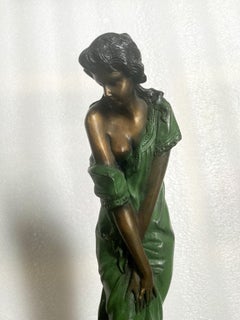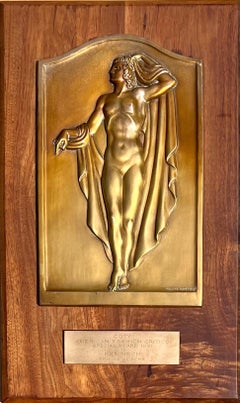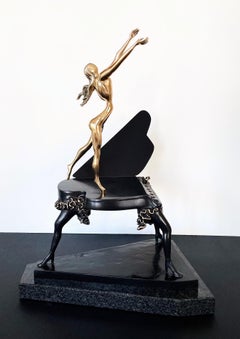Guy Lyman Fine Art Nude Sculptures
to
2
1
1
Overall Height
to
Overall Width
to
2
2
2
1
1
1
1
1
2
2
Winged David (Bronze), ex. Daniel Glaser Estate (New Orleans)
By Michelangelo
Located in New Orleans, LA
A tabletop-sized solid bronze casting of Michelangelo's "Winged David", on a solid marble base. You can see his giant-killer sling "slung" over his shoulder. Fine detail. This came out of a collection of neoclassical grand tour souvenirs, owned by collector Daniel Glaser of New Orleans, Louisiana (from his estate). Back in the day, wealthy travelers in Europe often purchased sculptures and other mementos of the sites they visited. We have several other pieces from this collection in addition to this, including "Discobolus" and a fine gladiator with lance. Proudly presented by Guy Lyman Fine Art...
Category
Early 20th Century Figurative Sculptures
Materials
Bronze
Demure Young Woman (Contemporary Bronze Sculpture)
Located in New Orleans, LA
A gorgeous solid bronze on marble pedestal depicting a demure young woman observing something that appears to be just in front of her. Is she a bit timid, perhaps? A lovely patina ha...
Category
21st Century and Contemporary Romantic Figurative Sculptures
Materials
Bronze
Related Items
1961 Coty Award Plaque Kenneth Hairdresser Jacqueline Onassis Bronze Fashion
Located in New York, NY
1961 Coty Award Plaque Kenneth Hairdresser Jacqueline Onassis Bronze Fashion
Bronze on wood. The wood plaque measures 12 3/4" by 20 3/4 inches. The bronze plaque itself is 13 3/4 x 8 3/4 inches and the the bronze inscription, which reads "COTY, American Fashion Critics Special Award 1961 to KENNETH of LILY DACHE...
Category
1960s American Modern Figurative Sculptures
Materials
Bronze
Piano surréaliste, Salvador Dali
By Salvador Dalí
Located in Fairfield, CT
Artist: Salvador Dali (1904-1989)
Title: Piano surréaliste
Year: 1984
Medium: Bronze
Edition: 34/350, plus proofs
Size: 26.3 x 15.7 x 12 inches
Condition: Excellent
Inscription: Inci...
Category
1980s Surrealist Figurative Sculptures
Materials
Bronze
Bronze Bust of Apollo Belvedere Grand Tour 19th Century
Located in Rochester, NY
Superb 19th century bronze and gilt bronze bust of the god Belvedere Apollo. Circa 1850. This wonderful grand tour bust is a marvel of refined beauty and elegance, crafted with richl...
Category
19th Century Figurative Sculptures
Materials
Marble, Bronze
French Art Deco Bathing Nude Female Statue by Guillaume Dumont 1923
Located in Oakland, CA
The French Art Deco Bathing Nude Female Statue, crafted by the Belgian sculptor Guillaume Dumont in 1923, is a testament to his artistic brilliance. Dumont, born in 1889, though the ...
Category
1920s Art Deco Figurative Sculptures
Materials
Bronze
H 18 in W 5.5 in D 4.5 in
Neoclassical Nude Sculpture of a Young Bacchus by Elias Hutter 19th Century
Located in Rochester, NY
Neoclassical bronze sculpture of a young Bacchus and fawn making an offering Elias Hutter. Very fine casting with a rich patina. Early to...
Category
Mid-19th Century Nude Sculptures
Materials
Metal, Bronze
Woman Seated A Bronze Sculpture of a Woman by Charles Rumsey
By Charles Cary Rumsey
Located in Brookville, NY
The bronze sculpture of a woman by Charles Rumsey is undated, but was created at a point in his career where he began to transition from realism to more modern, looser depictions of ...
Category
1920s American Modern Figurative Sculptures
Materials
Bronze
H 10.5 in W 11 in D 6 in
Louvre, Bronze after P. Julien Executed from a Marble Ordered by Marie-Antoinette
Located in Paris, FR
This splendid sculpture represents Young Girl with a Goat (Amalthea and Jupiter's Goat), after the original by Pierre Julien commissioned by Louis XVI in 1785 and completed in 1787 for the cot of Queen Marie-Antoinette in Rambouillet. The work of the sculptor Pierre Julien decorated the interior of a grotto in a pavilion decorated with bas-reliefs by the same sculptor
(acquired by the State by dation in 2003). The work was the main element of a rock basin, which was destroyed during the renovation of the gardens of the small castle.
The same sculpture was seized during the Revolution and exhibited in the Louvre from 1829. The terracotta sketch, which belonged to the collector Ernst May, must have adorned his château de la Couharde (Yvelines) before entering the Louvre's collections in 1920.
The bronze set with a beautiful gilded patina presented here is a work after the original by Pierre Julien (1731-1804) and dates from the 19th century (around 1850).
The superbly preserved sculpture, which has belonged to the same family since its acquisition, is presented on its original base in grey serpentine marble.
The quality of this work is doubly certified:
- on the one hand it is stamped with a round stamp at the top "A. This stamp is a sign of high quality. Achille Collas (1794 - 1859) was the French engineer, engraver and illustrator, inventor among other things of the patented mathematical reduction process of the 19th century to reproduce sculpted objects in reduction, which was very successful. He was awarded a prize at the 1855 exhibition: his "Procédé mécanique", the name under which he prints all his productions, is easily recognisable by the finesse of its execution and by the famous stamp which appears on the base (terrace) of this sculpture.
- On the other hand, an important signature is found on the terrace of the sculpture "F. Barbedienne Fondeur", founder. In 1844, Achille Collas, in order to protect his invention, formed the Société Collas et Barbedienne (Paris) with the art founder Ferdinand Barbedienne (1810-1892), which began to produce and sell famous but smaller sculptures in plaster, wood, bronze or ivory.
The first object to be marketed was the Venus de Milo after the original in the Louvre Museum. Other sculptures such as the sculpture of George Washington, of which a bronze bust was made by the Barbedienne & Process Collas foundry, are currently in the Metropolitan Museum of Art.
HEIGHT OF THE SCULPTURE without base 69CM + BASE = 84CM
WIDTH OF THE SCULPTURE without base 28 CM + BASE = 30,5 CM
LENGTH OF THE SCULPTURE without base 46 CM + BASE 51 CM
The Collas and Barbedienne company was highlighted at the Great Exhibition in London in 1851, the objects of the Barbedienne foundry received a medal and sales soared. At the 1889 Universal Exhibition in Paris, the Barbedienne company again presented a large number of its compositions, including the large neo-Renaissance clock of 1878.
This clock, which was part of the Leblanc-Barbedienne estate, was donated by his heirs to the city of Paris, and is kept in the city hall.
Pierre Julien (20 June 1731 - 17 December 1804) was a French neo-classical sculptor who worked in the full range of rococo and neoclassical styles.
He had an early apprenticeship in Le Puy-en-Velay, near his native village of Saint-Paulien, and then at the École de Dessin in Lyon, before entering the Paris workshop of Guillaume Coustou le Jeune. In 1765, he won the Prix de Rome for sculpture with a bas-relief panel depicting a subject from Antiquity and entered the Royal School for Protected Pupils, which offered a special curriculum under the direction of the painter Louis-Michel van Loo. He was a boarder at the Académie de France in Rome from 1768 to 1773, where he was influenced by the wave of neoclassicism affecting his fellow students. As boarders were required to do, he sent back to France a slightly reduced marble copy of the so-called Cleopatra, the Sleeping Ariadne from the Vatican, which survives in Versailles.
Back in France and with his former master, he worked on the sculpture of the mausoleum of Louis, the Grand Dauphin, in the cathedral of Sens. After a failed attempt in 1776, with his Ganymede, he was accepted by the Royal Academy of Painting and Sculpture in 1778, with a Dying Gladiator. He was appointed one of the first members of the Institut de France in 1795, and knight of the Legion of Honour in 1804.
He was commissioned by the Count of Angiviller, director of the King's Buildings, on behalf of Louis XVI, to paint the figures for a series of life-size portraits of the great men of France: he produced a Jean de La Fontaine and a Nicolas Poussin, whom he chose to depict in a nightgown, similar to the draperies of a Roman toga. While fulfilling commissions in Paris, for the church of Sainte-Geneviève (now the Panthéon, Paris), or for the Pavillon de Flore in the Louvre, he sculpted in 1785 a virtuoso marble set representing the nymph Amalthée and Jupiter's nurse goat for the Queen's Dairy at the Château de Rambouillet; for his model, he adapted the pose of the famous Venus of the Capitoline. The bas-reliefs of the Dairy, considered his masterpieces, were sold at auction in 1819, but were recovered by the State in 2005, thanks to a gift from the son of the great dealer-collector Daniel Wildenstein.
19th century French school, after Pierre Julien (1731-1804)Amalthea and Jupiter's Goat
Bronze with a light brown patina and gilding, reduction made after the marble by Pierre-Julien 1785 executed for Marie-Antoinette at the Laiterie du parc du château de Rambouillet in the Louvre Museum.
Among his major works:
- Dying Gladiator, marble, 1779, Musée du Louvre.
- Ganymede pouring nectar to Jupiter changed into an eagle, [4] marble group, 1776-1778, Paris, Musée du Louvre.
- Jean de La Fontaine, marble, 1783-85. Musée du Louvre
- Nicolas Poussin, marble, 1789 - 1804. Musée du Louvre
- Sketch of a model in terracotta by Nicolas Poussin, ca. 1787 - 1788. Musée du Louvre
- Amalthea and Jupiter's goat, marble group, 1787 for the Rambouillet Dairy. The Queen's Dairy at Rambouillet
- The girl with the goat, terracotta statuette, 1786. Louvre Museum
- Sainte Geneviève restoring her mother's sight, terracotta bas-relief, 1776. Musée du Louvre
The works of the famous sculptor Pierre Julien have been referenced in several books and catalogues, including
The exhibition catalogue. Gilles Grandjean and Guilhem Scherf. "Pierre Julien 1731-1804". Le Puy-en-Velay, France: Musée Crozatier, 2004.
The Lure of Classical Sculpture 1500-1900 (Yale University Press, 1981), cat. no. 24, pp 184-87).
Michael Preston Worley, 2003. Pierre Julien: Sculptor to Queen Marie Antoinette. The first modern monograph.
Europe in the age of enlightenment and revolution, a catalogue from the libraries of the Metropolitan Museum of Art (fully available online in PDF format), which contains information on Julien.
Excerpts from the Grove Dictionary of Art online
Pierre Julien in American Public Collections, on the French Sculpture Census website
STATUE BARE (BODY) NANNY GOAT (ANIMAL) AMALTHAEA SITTING WOMAN
ABOUT US:
AYN GALLERY is located in the heart of old Paris on the Ile Saint-Louis surrounded by the Seine, in the most prestigious district of Paris. Just a few steps away from Notre Dame, like a village, this place preserved from urbanists offers a setting as it existed centuries ago with its numerous private mansions which earned the island the nickname "island of palaces" and its illustrious occupants: Charles Baudelaire, Marie Curie, Georges Pompidou or Camille Claudel
Our gallery is located just opposite one of the oldest churches in Paris. As the eponymous name of the place indicates, Yasmine Azzi, the owner and artistic director of the place, has a keen eye. Born from the desire to bring together, in a unique space, vintage pieces of 20th century design, contemporary creations, original works of art and interior design know-how, AYN GALLERY was created in 2017.
Our gallery presents an eclectic and daring mix, driven by a total freedom of styles and periods. We offer a collection that combines aesthetics and authenticity, in a word what we like and what our customers like.
We offer an inspiring selection of furniture from the last century with rare antiques, but also precious objects and lighting with a special emphasis on vintage Italian...
Category
19th Century Rococo Figurative Sculptures
Materials
Marble, Bronze
H 33.08 in W 18.12 in D 12.01 in
Dancing Nude Bronze of a Woman "Femme Dansant, 1910"
By Charles Cary Rumsey
Located in Brookville, NY
Dancing Nude Bronze by Charles Rumsey is one of many figures he depicted of women. He has usually been known for his sculptures of horses, polo players, wildlife and dogs, mainly du...
Category
1910s Figurative Sculptures
Materials
Bronze
Maternité Allongée cm 90
By Antoniucci Volti
Located in Villafranca Di Verona, IT
Numbered and limited to 8 copies
Artwork signed
Authenticity: Sold with certificate of Authenticity from the Indivision Antoniucci Volti
Invoice from the gallery
Sculpture: bronze, ...
Category
1960s Nude Sculptures
Materials
Bronze
Bronze Roman Oil Lamp Mercury and Flying Cranes Grand Tour
Located in Rochester, NY
Roman verdigris bronze oil lamp. Flying cranes with running Mercury. After the original found in Pompeii. This lamp base would originally have had small oil lamps...
Category
19th Century Nude Sculptures
Materials
Bronze
NYDIA, THE BLIND FLOWER GIRL OF POMPEII Marble Sculpture 1856-1870
Located in Soquel, CA
Randolph John Rogers (American, 1825 - 1892) Randolph Rogers' Nydia, the Blind Flower Girl of Pompeii debuted in 1856 to critical and public acclaim, solidifying Rogers’ position as a pre-eminent American sculptor and it remains one of the artist’s most celebrated works today. The subject of Nydia is drawn from Edward Bulwer-Lytton's The Last Days of Pompeii 1834. After touring the ruins of the ancient city in 1833, and inspired by the stories of blinding volcanic ash, he composed the tale of Nydia, a slave who led her master, Glaucus, to safety. Rogers depicts Nydia at the moment that she and Glaucus have become separated in their perilous journey through the rubble and Nydia seeks familiarity in the surrounding chaos, her distress evident in her pained expression. The grace of the sculpture is at odds with the turmoil portrayed; a toppled Corinthian capital lies at her feet and obstructs her next step, indicated by the tilt of her back foot and grip on her walking stick. Examples of this model can be found in major American collections, including The Metropolitan Museum of Art, the Art Institute of Chicago, the Detroit Institute of Arts, the Los Angeles County Museum of Art, and the Museum of Fine Arts, Boston.
Literature, Millard F Rogers, Jr. Randolph Rogers, American Sculptor in Rome. University of Massachusetts Press, 1971, American Figurative Sculpture in the Museum of Fine Arts Boston. Museum of Fine Arts, Boston, 1986. Joyce K Schiller. "Nydia, A Forgotten Icon of the Nineteenth Century." Bulletin of the Detroit Institute of Arts,
Born in Waterloo, New York, Randolph John Rogers became an expatriate* sculptor of idealized figures, portraits, and commemorative works in Neo-Classical* and Realist* styles. He worked in clay, plaster, marble and bronze, and lived both in Italy and the United States. He made 167 examples of Nydia in two sizes (varies depending on base height) 36" and 54'.
Rogers was raised in Ann Arbor, Michigan, and as a young man did woodcuts* for the local newspaper, The Michigan Argus, and also worked as a baker's assistant and a dry goods clerk. In 1847, he moved to New York City, where he hoped to find work as an engraver*, but failing to do so, worked in a dry goods store owned by John Steward...
Category
Mid-19th Century Romantic Figurative Sculptures
Materials
Marble
"Mercury" NYC 1931 Bronze 5th Ave Traffic Light Sculpture American Art Deco WPA
Located in New York, NY
"Mercury" NYC 1931 Bronze 5th Ave Traffic Light Sculpture American Art Deco WPA
In the late 1920s, Joseph Freedlander was asked by the City of New York ...
Category
1930s Art Deco Figurative Sculptures
Materials
Bronze


